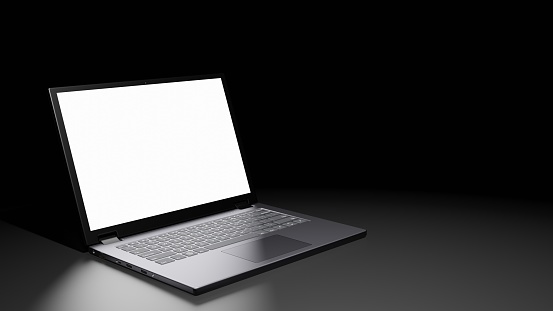Laptop notes keep students from learning

Getty Images
Opened laptop with blank screen display on the floor in a dark room.
September 10, 2021
Note taking sucks; it’s slow, tedious and easy to miss exactly what the professor said. Taking the time to write your notes by hand, though, is actually how you learn— not with a blank page of Google Docs in front of you.
With laptops being nearly ubiquitous in 2021, most students can probably type faster than they can write. Taking notes on a laptop is faster, arguably more efficient and it’s easier to carry around a laptop than multiple notebooks.
In 2011, over half of all college graduates had previously used laptops to take notes digitally. That number has almost definitely grown since then.
Writing too slowly and missing what the professor said is quickly becoming a problem of the past.
But new problems have popped up in its place.
Laptops are distracting. They’re loud. They’re too bright. They’re much harder to ignore than a simple pen and paper.
Students aren’t exactly known for having long attention spans. In fact, some psychologists believe that the attention span of a student is only about 10 to 15 minutes long. While this claim is unsupported, it’s true that some students will inevitably get bored in class.
And with a laptop in front of them, they aren’t just limited to daydreaming or doodling in their notebooks. Instead, they can shop, message friends, watch videos and even do assignments for other classes.
Maybe laptops are more entertaining, but in terms of actually taking good notes, handwritten ones are at least less distracting.
Even when students are paying attention and typing notes, the results are simply not as good as when students hand‑write their notes.
According to a study published in Psychological Science, “present research suggests that even when laptops are used solely to take notes, they may still be impairing learning because their use results in shallower processing.”
This is because, by using laptops, students can quickly type what the professor says verbatim. But that isn’t as useful as it may seem.
By copying exactly what the professor says, students don’t actually have to think about or sort through any information.
Essentially, instead of taking notes and processing information, students are really just transcribing lectures— but how likely are they to go back and look at their “lecture notes?” I surely wouldn’t want to read the transcription of a lecture.
Instead, by handwriting notes, students are forced into thinking more deeply about the topic they are writing about.
According to a study published in the Media Education Research Journal, “listening to a lecture requires a phonological processing, but writing the ideas heard also requires their «translation» into orthographic processing, which can facilitate information recall.”
The same study suggests that handwritten notes can stimulate more stable synapses, which means students will be able to remember what’s in their notes for longer.
As technology is increasingly available, students will continue to use and adapt it to their needs. In this case, however, the cons outweigh the pros— laptops are distracting, loud and not actually all that great for taking notes.






